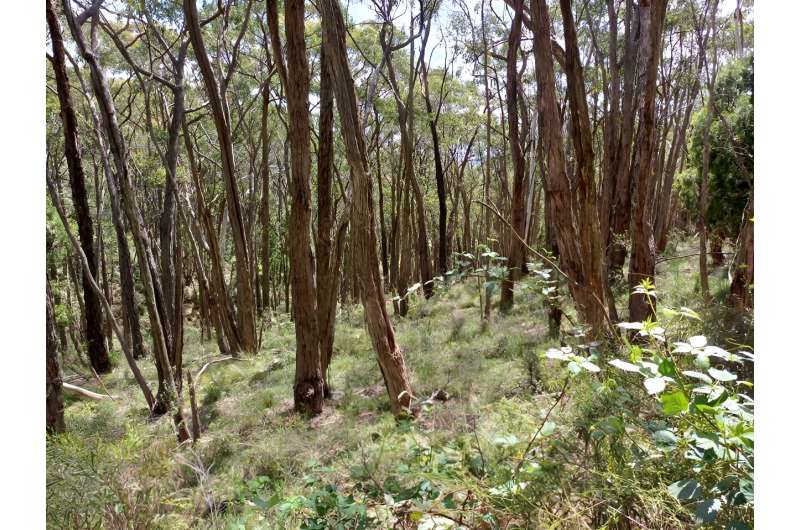This article has been reviewed according to Science X's editorial process and policies. Editors have highlighted the following attributes while ensuring the content's credibility:
fact-checked
peer-reviewed publication
trusted source
proofread
Night study of native plant survival

With land clearance, bushfires, weeds and climate change, small pockets of native vegetation are important for future plant and animal conservation—but do plants in small reserves struggle with reduced habitat for both plants and their pollinators?
This question has led Flinders University researchers to take a close look at whether the reproductive output of a common moth-pollinated plant is lower in small conversation reserves near Adelaide.
In one of few studies globally to focus on the possible negative impacts of small patch sizes of native vegetation focusing on native plants with nocturnal moth pollinators, the researchers compared levels of reproduction in the common flowering Australian moth-pollinated plant (Stackhousia aspericocca ssp Cylindrical inflorescence) across conservation reserves ranging in area from around 1 hectare to about 1,000ha.
The article, "Impact of reserve area on reproduction of a moth-pollinated Stackhousia Sm. (Celastraceae) species in a fragmented landscape," has been published in Austral Ecology
"Our study found that a variety of night-flying moths, including species common in the Adelaide Hills, visited the flowers and carried pollen of the plant across small and large conservation reserves," says Dr. Alex Blackall, who recently completed a Ph.D. at the Flinders College of Science and Engineering.
"We found that reproduction of the plant in small reserves was similar to that measured in larger reserves of native vegetation."
The research seeks to address whether plants are able to successfully reproduce and survive long term in small patches—given small remnant vegetation patches may be able to contribute significantly to the conservation of native plants.
Previous studies in Australia have indicated that both pollination and reproduction of plant species may decline in small areas of native vegetation.
"Whether plants are able to successfully reproduce and survive long-term in such small patches is not always clear and lower plant reproduction in smaller patches of vegetation would certainly be of conservation concern," says Dr. Blackall.
"Particularly with climate change and other pressures, field-based ecology research over multiple years examining both plant-pollinator interactions and associated plant reproduction is more important than ever."
The article used data collected at several sites in the Adelaide Hills between 2017 and 2019 and included video recordings and researcher observations of flower visitations by the pollinating moths.
"We found these inconspicuous insects remove and can carry large amounts of pollen, similar to the recent findings for Bogong moths in the Australian Alps (Coates et al, 2023).
"Our study provides a clear example of the role of moths in pollinating Australian native plants, which is a very understudied interaction," adds Dr. Blackall.
While the researchers were heartened to find robust levels of plant reproduction in smaller reserves in their study, they noted that studies of recent declines in moth, common butterfly and other pollinator species in southern Australia raise concerns about future pollinator abundance and diversity in the study region and possible impacts on the pollination and reproduction of native plants in the future.
For example, see "Temperature during pupal development affects hoverfly developmental time, adult life span, and wing length," by K Daňková, S Nicholas and K Nordström, published in Ecology and Evolution.
More information: Alex G. Blackall et al, Impact of reserve area on reproduction of a moth‐pollinated Stackhousia Sm. (Celastraceae) species in a fragmented landscape, Austral Ecology (2023). DOI: 10.1111/aec.13444
Journal information: Ecology and Evolution
Provided by Flinders University




















